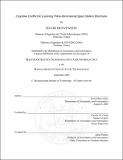| dc.contributor.advisor | Charles M. Oman. | en_US |
| dc.contributor.author | Benveniste, David, 1977- | en_US |
| dc.contributor.other | Massachusetts Institute of Technology. Dept. of Aeronautics and Astronautics. | en_US |
| dc.date.accessioned | 2005-09-06T19:57:40Z | |
| dc.date.available | 2005-09-06T19:57:40Z | |
| dc.date.issued | 2004 | en_US |
| dc.identifier.uri | http://hdl.handle.net/1721.1/26750 | |
| dc.description | Thesis (S.M.)--Massachusetts Institute of Technology, Dept. of Aeronautics and Astronautics, 2004. | en_US |
| dc.description | This electronic version was submitted by the student author. The certified thesis is available in the Institute Archives and Special Collections. | en_US |
| dc.description | "September 2004." | en_US |
| dc.description | Includes bibliographical references (p. 87-88). | en_US |
| dc.description.abstract | (cont.) reached very high values early in the experiment and was significantly but slightly lower in FC than in GC. The target position relative to the subject's body did not affect performance, but subjects responded significantly faster when they were visually upright than when they were upside-down. Although alternative explanations cannot be ruled out, data collected and subjects' comments suggest that unlearning the GC cognitive map posed a significant challenge, and that subjects' knowledge of modules in GC, acquired earlier in the experiment, impeded their learning in FC, at least for the complex FC we used. Results of a Perspective Taking Ability test correlated weakly but significantly with TTR performance in GC, but not in FC. Other tests of spatial skills showed no significant correlation with performance. The effects of motion sickness susceptibility and of gender are also discussed. Supported by NASA Cooperative Agreement NCC 9-58 with the National Space Biomedical Research Institute. | en_US |
| dc.description.abstract | Astronauts train on the ground in normal gravity, in replicas of the space station. Physical constraints force the configuration of these modules on the ground to be different from the configuration of the space station in flight. Based on descriptions of mishaps in human wayfinding (Jonsson 2002), it was hypothesized that the cognitive map of the space station formed from the replicas on the ground could be hard to unlearn. Could the resulting conflict with the actual configuration in flight explain why astronauts lack survey knowledge and often lose track of their orientation? Can they be trained using virtual reality to learn the correct configuration? What makes a configuration hard to learn or unlearn? We studied the ability to learn two realistic and polarized cubic modules in immersive virtual reality. Subjects (n=19) learned these modules first separately, then attached in two different configurations: first a "ground configuration" (GC), then a "flight configuration" (FC). The intrinsic visual verticals of both modules matched in GC, but not in FC, and walls at the interface between the modules were different in the two configurations. Subjects received guided tours of the modules and, through repeated trials, had to predict the location and orientation of one wall (the target), using the wall they were facing. The environment was pseudo-randomly rotated between trials. In the two module environments, subjects were set in the first module and had to place and orient the target wall in the second. The total time to respond to each trial (TTR) and the percent of correct responses (%-correct) were measured. The TTR decreased continuously with time within each virtual environment, but was significantly larger in FC than in GC. %-Correct | en_US |
| dc.description.statementofresponsibility | by David Benveniste. | en_US |
| dc.format.extent | 128 p. | en_US |
| dc.format.extent | 999309 bytes | |
| dc.format.extent | 2607422 bytes | |
| dc.format.mimetype | application/pdf | |
| dc.format.mimetype | application/pdf | |
| dc.language.iso | en_US | |
| dc.publisher | Massachusetts Institute of Technology | en_US |
| dc.rights | M.I.T. theses are protected by copyright. They may be viewed from this source for any purpose, but reproduction or distribution in any format is prohibited without written permission. See provided URL for inquiries about permission. | en_US |
| dc.rights.uri | http://dspace.mit.edu/handle/1721.1/7582 | |
| dc.subject | Aeronautics and Astronautics. | en_US |
| dc.title | Cognitive conflict in learning three-dimensional space station structures | en_US |
| dc.type | Thesis | en_US |
| dc.description.degree | S.M. | en_US |
| dc.contributor.department | Massachusetts Institute of Technology. Department of Aeronautics and Astronautics | |
| dc.identifier.oclc | 60458754 | en_US |
